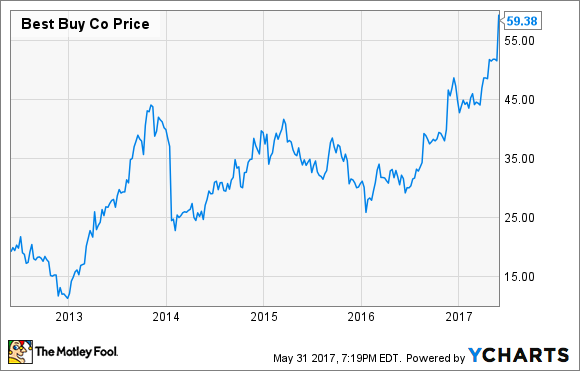Investors finally seem to have abandoned the notion that Best Buy (BBY 2.04%) is doomed to fail due to the rise of Amazon.com (AMZN 0.17%) and other e-commerce retailers.
Thanks to a string of good earnings reports, investors are finally starting to believe that Best Buy has long-term earnings growth potential. Indeed, Best Buy stock hit a new all-time high last week after the company posted better-than-expected first quarter results. A key factor in this renaissance is that much of Best Buy's traditional competition has disappeared -- or is about to.
Best Buy Stock Performance, data by YCharts.
Best Buy is getting back on track
Less than five years ago, Best Buy stock briefly plunged to less than $11. At the time, Best Buy was suffering from a slowdown in sales and falling margins. Investors were worried that "showrooming" represented an existential threat to the company. In other words, consumers might come to Best Buy to look at products, but they would then order from Amazon to get a better price.
Under CEO Hubert Joly, Best Buy responded to this threat by aggressively cutting costs and simultaneously reducing its prices. It also implemented a price-matching policy, so that customers wouldn't walk out if they found a better price on Amazon. Lastly, Best Buy has invested in improving its own e-commerce business.
The price-matching policy in particular was quite effective in stemming Best Buy's market share losses to Amazon. Meanwhile, cost cuts helped offset the modest gross margin pressure that Best Buy has experienced due to price-matching and outright price reductions.
Earnings growth accelerates
While it didn't take long for Best Buy to stabilize its comp sales trends, earnings growth proved more elusive. Adjusted earnings per share fell from $3.61 in fiscal 2012 to a nadir of $2.07 in fiscal 2014. While adjusted EPS recovered somewhat thereafter, Best Buy earned just $2.78 per share (well below the previous peak) as recently as fiscal 2016.

Best Buy's EPS has finally rebounded from a multiyear funk. Image source: Best Buy.
Best Buy finally regained some earnings momentum last year (fiscal 2017). Adjusted EPS rebounded to $3.56 thanks to margin expansion, even though revenue was roughly flat year over year. That said, the company entered fiscal 2018 with a very modest outlook, calling for revenue and operating income to be roughly flat excluding the impact of having a 53rd week this fiscal year.
This guidance appears to have been too conservative, though. Last quarter, Best Buy blew past expectations with a 1.4% domestic comp sales increase and a 4% international comp sales increase. Margins also beat expectations, allowing Best Buy to post EPS of $0.60, 50% ahead of the average analyst estimate. The company also raised its full-year guidance.
The competition is reeling
The improvement in sales and earnings trends at Best Buy can be traced in large part to a less competitive environment. Of course, one-time rival Circuit City went bust during the Great Recession. More recently, Best Buy has been profiting from the slow demise of Sears Holdings (SHLDQ).
Five years ago, Sears was the No. 1 appliance seller in the U.S. But it has closed hundreds of stores, while customer traffic at the remaining locations has plunged. Best Buy has been a big beneficiary, posting strong growth in its appliance business in recent years. Indeed, Best Buy highlighted improved appliance margins as a key driver of last quarter's strong profit.
Meanwhile, Sears Holdings has pulled back from the consumer electronics market in order to focus on more profitable product categories. This is helping Best Buy as well.
More opportunity ahead
The competitive landscape is about to get even easier for Best Buy. HHGregg, one of Best Buy's few remaining direct competitors, filed for bankruptcy earlier this year and recently finished liquidating its 220 stores. RadioShack has also shut down nearly all of its remaining stores this year after filing for bankruptcy a second time. Barring a miraculous turnaround, Sears Holdings could follow their lead in a couple of years.
Of course, Amazon.com will still be around to keep Best Buy honest. But with several of its biggest brick-and-mortar competitors out of the picture, Best Buy will face a much more benign competitive environment going forward.
Best Buy should see an immediate sales lift as former HHGregg and RadioShack customers change their shopping habits. It may also be able to improve its gross margin somewhat due to the reduced competition in certain categories.
Best Buy stock isn't especially cheap anymore. However, if the company can continue to capitalize on the demise of its rivals, there could still be more upside ahead.






